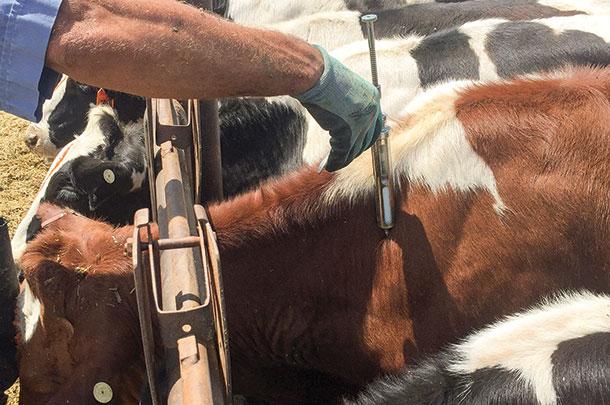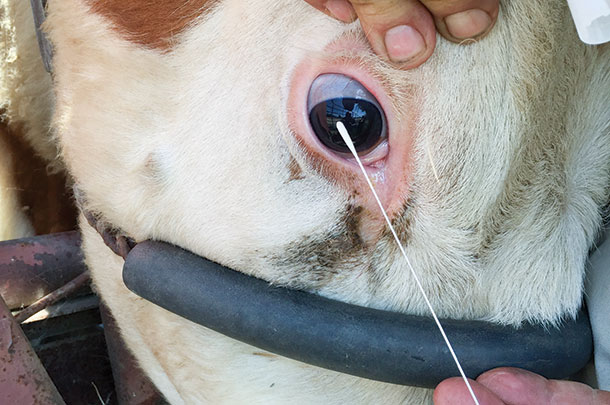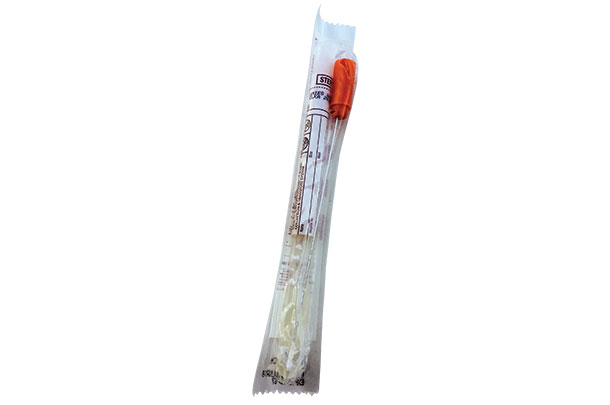If a vaccine does not perform to satisfaction, or does not include protection against the strain of pathogen causing trouble in a particular herd, or there’s no vaccine for a specific disease, one option is an autogenous vaccine.
This is a custom-made vaccine, often called a herd-specific vaccine, utilizing a pathogen isolated from animals within that herd. The pathogen sample is sent to a laboratory that cultures and grows it, creating the vaccine specifically for that herd.
Bruce Addison of Addison Laboratories in Fayette, Missouri, says many beef producers utilize autogenous vaccines for pinkeye control since commercial pinkeye vaccines only target Moraxella bovis (one of several bacteria that can cause pinkeye) and do not protect against other pathogens that can cause infection in the eye.

One reason commercial vaccines don’t always work is that many pathogens keep changing. “Antigenic shift occurs frequently in nature,” explains Addison.
“Organisms mutate and change over time. It’s a big investment in time and money to license a new vaccine. Eventually, some of these vaccines quit working as well as they used to because of changes in the microbes.
“For example, with pinkeye we’ve been dealing with an oddball strain for more than 20 years. Dr. John Angelo at UC – Davis finally named it Moraxella bovoculi. There is no commercial vaccine for it, so autogenous is the only approach, though right now we are finishing up development of a commercial vaccine. It takes time to go through all the processes to have a vaccine approved, but this one is greatly needed,” Addison says.
“Those two pinkeye organisms tend to work together. The bovoculi infection by itself isn’t very severe, but with M. bovis, it becomes quite serious. You often need protection from both in order to prevent pinkeye,” he says.
 Addison adds that all producers of autogenous vaccines are regulated by USDA. “You must be licensed and facilities inspected. There are many rules to follow, and a licensed veterinarian must be involved to ensure a correct diagnosis. A vaccine that contains the wrong ‘bug’ won’t help.”
Addison adds that all producers of autogenous vaccines are regulated by USDA. “You must be licensed and facilities inspected. There are many rules to follow, and a licensed veterinarian must be involved to ensure a correct diagnosis. A vaccine that contains the wrong ‘bug’ won’t help.”
There are several other labs around the country that produce autogenous vaccines for clients, including Phibro Animal Health Corporation.
“We create many different autogenous bacterins and vaccines for the livestock industry,” says Mike Murphy, senior manager of commercial operations. This company operated as MVP Laboratories for 35 years and, in January 2016, was acquired by Phibro Animal Health in Omaha, Nebraska.
“When MVP started, we were mainly producing canine parvovirus vaccine and intrastate swine vaccines. We did a few autogenous vaccines for cattle early on and have significantly grown that market the past 15 years,” says Murphy.
Obtaining an autogenous vaccine
“Ranchers and veterinarians can obtain USDA-approved vaccines very quickly from ethical suppliers, but an autogenous vaccine takes longer,” says Addison. “You first wait for a diagnosis (which may mean blood or tissue samples sent to a diagnostic laboratory), then a lab isolates and purifies the organism. Then it takes 14 to 30 days to produce the vaccine,” he explains.

Dr. Jeff Kula, technical services veterinarian with Phibro, says autogenous vaccines are similar to a prescription on order of the attending veterinarian to address a disease the veterinarian diagnoses is a problem in a client’s herd. “We make a custom vaccine to the veterinarian’s specifications, with input from our in-house diagnostics services,” says Kula.
“Samples are taken from the sick animal, such as a swab from an affected eye in the case of pinkeye, or a fecal sample from an animal with an intestinal infection, or a tissue sample for many other diseases. We must get that pathogen isolated in pure culture,” says Kula.
For instance, a producer might be losing calves to acute toxic gut infections that act like the “enterotoxemia” caused by Clostridium perfringens type C and D, which are included in many seven- or eight-way clostridial toxoid vaccines. Yet in spite of diligent vaccination, calves keep dying. The cause might be another type of C. perfringens that is not included in the vaccine.
“We see this happen fairly often, with perfringens type A or even type E,” says Addison. “It’s not that the vaccines aren’t good products; they just don’t cover that particular pathogen or, in some instances, the pathogen has changed,” he explains.
Addison Laboratories creates autogenous vaccines for cattle (beef and dairy) and also for sheep, goats and pigs. “We do Pasteurellas, E. coli, Salmonella and many other pathogens. I don’t usually recommend autogenous vaccines for Pasteurella or Mannheimia in cattle, since there are good commercial products for that one,” he says.
There are also autogenous vaccines for warts. “I did that for years, but we have not renewed our license for that – partly because it’s a nasty job making those vaccines, and partly because our staff has been so busy with other things,” says Addison.
He works with veterinarians all over the U.S. to create and provide specific in-herd vaccines. “One of the veterinarians I work with in Missouri is Dr. Ken Vroman, who has used autogenous vaccines for many years.” Vroman started practice in 1971 and began using autogenous vaccines shortly after that.
“When there were still a lot of hogs in this area, we used autogenous vaccines in hogs,” says Vroman. “Today, we have a beef cattle practice, and the main thing we use autogenous vaccine for is pinkeye. We’ve been using autogenous pinkeye vaccines for 25 years."
"It’s not a panacea; it goes hand-in-hand with good management. It also seems to have an additive effect. When you go through a herd and give them all an autogenous vaccine for one or eye control the second year that you use the vaccine. It’s like a booster to build up herd immunity,” he explains.
“With a pinkeye vaccine, we also have to determine whether to include Mycoplasma. The eye disease can be worse when this pathogen is involved. A good autogenous vaccine can be used after you straighten out any management problems and your veterinarian has helped you diagnose the disease – and come to the conclusion that the vaccine you are using isn’t touching this particular bug,” says Vroman. ![]()
PHOTO 1: Bruce Addison, owner of Addison Laboratories. Photo provided by Bruce Addison.
PHOTO 2: The autogenous vaccine can be administered to every animal in the herd.
PHOTO 3: Pinkeye samples are taken using a swab to collect material from the center of the eye.
PHOTO 4: Kit sent to veterinarians for taking eye swabs to send in to the lab. Photos provided by Gary Spina.

-
Heather Smith Thomas
- Freelance Writer
- Salmon, Idaho
Can an autogenous vaccine be used by multiple herds?
“Autogenous vaccines were originally specific to a certain herd or ranch,” says Mike Murphy, senior manager of commercial operations, Phibro Animal Health.
“Years ago, the Virus Serum Toxin Act (USDA guideline regulating autogenous products) stated that these vaccines were only to be used in the herd of origin. With changes in how livestock are raised, the exception – for nonadjacent use of vaccines – has become more accepted,” he says.
“As long as we have nonadjacent approval from the state veterinarian in the state the product is to be used in, we can make a vaccine to be used in more than one herd."
"However, we need to establish a legitimate connection between herds in order to do this, such as cattle from multiple herds in close proximity to each other in adjacent pastures, common breeding groups (on public range) or commingled in facilities like a sale barn. As long as the veterinarian can put that stipulation on the vaccine, it can be used at multiple locations with nonadjacent approval,” says Murphy.
Dr. Paul Cotterill, Cherryvale, Kansas, has used various autogenous vaccines for about 15 years and has given more than 100,000 doses. “In our area – 40 miles either direction – there are owners who share pastures or have fenceline contact with other herds on pastures they rent.
Cattle hauled to pasture 20 miles or so either direction become exposed to cattle hauled 20 miles from a different direction. There is exposure over a large area. This is why we get good benefit from our autogenous vaccine, even for clients with herds that are not right next door to each other,” he explains.








